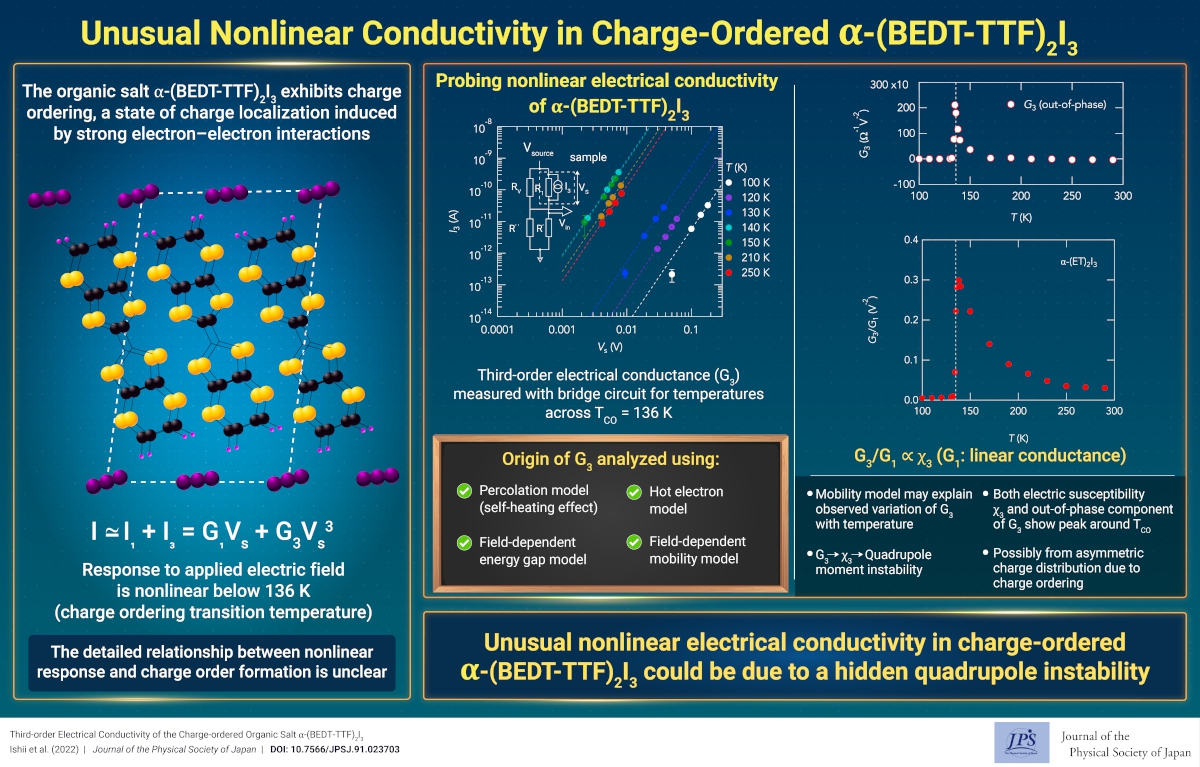Unusual Nonlinear Conductivity in Charge-Ordered α-(BEDT-TTF)2I3
© The Physical Society of Japan
This article is on
Third-order Electrical Conductivity of the Charge-Ordered Organic Salt Alpha-(BEDT-TTF)2I3
J. Phys. Soc. Jpn. 91, 023703 (2022).
Unusual nonlinear conduction is detected in organic molecular salt α-(BEDT-TTF)2I3. The observed third-order nonlinear conductivity implies a quadrupole instability hidden in this charge-ordered organic salt.

When voltage V is applied to the sample, electrical current I proportional to the voltage flows as V = R × I or I = G × V, where R and G (= 1/R) denote the resistance and conductance, respectively. This is the well-known Ohm’s law, also called as the linear conduction because of a linear relationship between current I and voltage V.
In contrast, several materials show nonlinear conduction, in which current I is not proportional to voltage V. The representatives are the nonlinear semiconductor devices such as diodes and transistors, as widely used in modern electronics. Recently, nonlinear conduction has also been observed in various correlated insulators, and it becomes a challenging issue to clarify the underlying mechanism of the nonlinearity.
A peculiar class of the organic-molecular-based compounds hosts an emergent electron crystal called “charge order,” in which the electrons are arranged periodically owing to the Coulomb repulsion. It provides a fascinating playground to study the nonlinear conduction because such a charge crystal may be highly sensitive to the external electric field as the normal crystal is affected by the external mechanical force. Indeed, organic salt α-(ET)2I3, in which the charge order emerges at TCO = 136 K, exhibits interesting nonlinear transport such as a collective sliding motion of charge order above the threshold field.
In the present study, the authors aim to examine the low-field nonlinear response of charge-ordered salt α-(ET)2I3 by a harmonic conductivity experiment. Generally, the nonlinear conduction can be expressed as a Taylor series of current I as I = G1V + G2V2 + G3V3 …, where Gi denotes the ith-order conductance. The first term on the right-hand side is the Ohmic term. In this experiment, a bridge circuit technique was utilized to accurately detect third-order conductance G3.
The authors note that the third-order conductance of α-(ET)2I3 is critically enhanced near the charge order transition temperature. As the origin, a close relation between the third-order conductance and the third-order electric susceptibility has been discussed. Thermodynamically, the third-order susceptibility may relate to a quadrupole moment; thus, the present results imply a quadrupole instability hidden in the charge-ordered organic salt.
Although the crystal structure of molecular-based compounds appears very complicating at the first glance, it is greatly simplified by regarding the complicated molecule as a point-like charge (electric monopole). The present results indicate that the asymmetric charge distribution in the molecule unit with a higher-order quadrupole moment is essential to thoroughly understand various intriguing properties of molecular solids.
(Written by R. Okazaki on behalf of all authors)
Third-order Electrical Conductivity of the Charge-Ordered Organic Salt Alpha-(BEDT-TTF)2I3
J. Phys. Soc. Jpn. 91, 023703 (2022).
Share this topic
Fields
Related Articles
-
Discovery of Light-Induced Mirror Symmetry Breaking
Dielectric, optical, and other properties in condensed matter
Electronic transport in condensed matter
2024-9-2
The authors discovered the light-induced mirror symmetry breaking, paving the way for controlling mirror symmetries via light and for realizing various phenomena utilizing the mirror symmetry breaking.
-
Discovery of Unconventional Pressure-Induced Superconductivity in CrAs
Superconductivity
Electronic transport in condensed matter
2024-8-13
A new study has discovered pressure-induced superconductivity in the helimagnet CrAs, originating in the vicinity of the helimagnetic ordering, representing the first example of superconductivity in Cr-based magnetic systems.
-
Antiferromagnetism Induces Dissipationless Transverse Conductivity
Electronic transport in condensed matter
Magnetic properties in condensed matter
Electronic structure and electrical properties of surfaces and nanostructures
2024-7-24
An investigation using high-quality NbMnP crystals demonstrates that the anomalous Hall conductivity arising from antiferromagnetism is dissipationless, as expected from the intrinsic mechanism.
-
Exploring Electronic States in BEDT-TTF Organic Superconductors
Superconductivity
Electronic transport in condensed matter
Magnetic properties in condensed matter
2024-4-24
This review, published in the Journal of the Physical Society of Japan, provides a comprehensive summary of the electronic states observed in BEDT-TTF type organic superconductors, including metal-insulator transitions, Mottness transitions, non-Fermi liquids, quantum spin liquids, and Bose-Einstein condensation.
-
Conversion of Chiral Phonons into Magnons in Magnets
Electronic transport in condensed matter
2024-4-1
A new phenomenon involving the conversion of chiral phonons into magnons is theoretically predicted. The effective magnetic field induced by chiral phonons causes a change in the spin magnetization of magnets.
